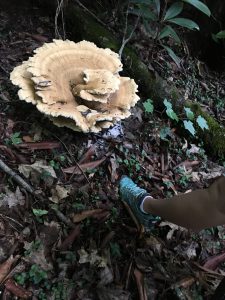Here, there, and everywhere!
With all the rain of late, there seems to be an interest in mycology. You know, the fruiting body of fungi called mushrooms! Edible mushrooms in particular.
It is not unusual; our subtropical summer weather tends to make some fungi flourish! Moreover, apparently, there is a bumper crop of fungi this year. Phone calls to the University of Florida IFAS Extension office about eating mushrooms has increased. Individuals have even brought mushrooms to the office, inquiring if they are of the edible variety.
Our reputation as Extension Agents certainly would be damaged if we did not adhere to a few rules… always read a label, use research-based information, and NEVER tell anyone that a mushroom is edible. It is not that there are not delicious wild mushrooms out there; a recent July 2017 publication of Microbiology Spectrum estimates millions of species. However, even the scientists do not agree, as only about 120,000 of them have been described so far. Not all are edible. Some fungi are poisonous to the point of being deadly.
Dr. Matthew Smith, Assistant Professor in the Department of Plant Pathology, knows a lot about mycology. In fact, he also is curator of the UF Fungal Herbarium (FLAS), managed by the UF Department of Plant Pathology at the Florida Museum of Natural History in Gainesville. The Fungal Herbarium is a valuable resource; its collections have many important aspects, including information about fungi that are deadly poisonous to humans and pets when consumed.
In addition, the UF Fungal Herbarium is participating in a National Science Foundation-funded project to digitize and database as many US macrofungi collections as possible. This project (The Macrofungi Collection Consortium) includes 34 institutions in 24 states. The project began in July 2012 and will aim to capture data for roughly 1.3 million fungal specimens. Persons interested in visiting the fungal herbarium should contact Dr. Matthew Smith, trufflesmith@ufl.edu.
With that said, there is enough scientific research out there to conclude mushroom identification is indeed difficult. Many mushrooms look similar, but are oh so different!
If you are truly interested in eating what you forage, MAKE time to study with experts! Mushrooms you plan to eat that are not identified correctly could send you to the emergency room … or worse. The toxicity of a mushroom varies by how much has been consumed. Poisoning symptoms range from stomachaches, drowsiness, and confusion to heart, liver, and kidney damage. The symptoms may occur soon after eating a mushroom or can be delayed for six to 24 hours.
Delayed symptoms are common. Seek help immediately if you think you may have eaten a poisonous mushroom, even if there are no obvious signs of toxicity. Call the Poison Center’s 24-hour emergency hotline at 1-800-222-1222. You will receive immediate, free, and confidential treatment advice from the poison experts.
And if you are determined to make foraging for food a recreational hobby or even want to learn more about what is in your Florida yard, Common Florida Mushrooms by Dr. James Kimbrough, Emeritus Faculty, University of Florida’s Institute of Food and Agricultural Sciences, identifies and describes 268 species of mushrooms found in the Sunshine State.
Most importantly, teach your children to NEVER eat any mushroom picked from the ground. It is indeed better to be SAFE than sorry!
- It’s Chestnut Season! - December 16, 2022
- Persimmons: Food of the Gods - November 23, 2022
- Have You Ever Thought About Entering Baked Goods in the North Florida Fair? - October 28, 2022

